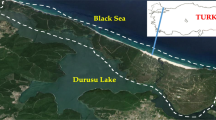Abstract
Ecosystems on dunes are influenced by critical environmental factors (mineral nutrients, water deficiency, etc.) considered decisive for their existence. The present paper is based on studies carried out on dunes on the coastal area of the Baltic Sea, southwest Estonia. The nature of forest ecosystems on dunes was studied from the aspects of chemical characteristics of soil, vascular plant species richness and diversity. Sampling sites on the dunes with different heights were selected in Cladina and in Vaccinium vitis-idaea site-type Scots pine forests. Vascular plant species richness and diversity were related to edaphic gradients. On the dune with a height of 32.1 m a.s.l., significant relationships were revealed between the number of species of ground vegetation, pH, volumetric water content in soil and the position of the sample plots. No relationships were revealed between the number of vascular plant species, soil pH, volumetric water content and mineral nutrients on the dune with a height of 9 m a.s.l. The most frequent and abundant plant species on the higher dune were Deschampsia flexuosa, Vaccinium vitis-idaea and V. myrtillus; the highest number of species were found at the bottom of the dune, while on the top only some xeromorphic species such as Festuca ovina, Sedum acre and Crepis tectorum occurred. On the lower dune, the most frequent were Vaccinium vitis-idaea, V. myrtillus and Melampyrum pratense, while V. uliginosum was found only on the bottom and slope and Empetrum nigrum on the top of the dune.

Similar content being viewed by others
References
Baldwin KA, Maun MA (1983) Microenvironment of Lake Huron sand dunes. Can J Bot 61:241–255
Eltermann G, Raukas A (1966) Eesti luidete kujunemisest ja ehitusest (Estonian dunes: their formation and structure). Eesti Loodus 1:12–18 (in Estonian)
Isermann M (2005) Soil pH and species diversity in coastal dunes. Plant Ecol 178:111–120
ISO/10390 (1994) Soil quality. Determination of pH. International Organization for Standardization, Geneva
ISO/11260 (1995) Soil quality. Determination of CEC and base saturation. International Organization for Standardization, Geneva
ISO/11261 (1995) Soil quality. Determination of total nitrogen. Modified Kjeldahl method. International Organization for Standardization, Geneva
Jackson RB, Caldwell MM (1993) Geostatistical patterns of soil heterogeneity around individual perennial plants. J Ecol 81:683–692
Jarmalavičius D (2005) Field investigation of dune ridge reinforcement in the Curonian spit. Baltica 18(2):49–55
Kalda A (1970) Välibotaanika (Field Botany). Tartu Riiklik Ülikool, Tartu (in Estonian)
Koehler H (1998) Gradients in soil and small biota on the beach and in the dune and its implications for recreation management. A case study on Houstrup Strand (Denmark). Coastline 2:8–10
Kooijman AM, Dopheide JCR, Sevink J, Takken I, Verstraten JM (1998) Nutrient limitation and their implications on the effects of atmospheric deposition in coastal dunes; lime-poor and lime-rich sites in Netherlands. J Ecol 86:511–526
Łabuz TA (2004) Coastal dune development under natural and human influence on Swina Gate Barrier (Polish coast of Pomeranian Bay). In: Schernewski G, Löser N (eds) Managing the Baltic Sea. Coastline reports 2. EUCC, The Coastal Union, Warnemünde, pp 129–138
Mandre M (2003) Conditions for mineral nutrition and content of nutrients in Scots pine (Pinus sylvestris) on dunes in Southwest Estonia. Metsanduslikud Uurimused (Forestry Studies) 39:32–42
Mandre M, Pärn H, Tilk M, Kõresaar P, Kõresaar K, Kösta H (2006) Diversity of soil conditions and plant cover of Scots pine forest on coastal dunes in Southwest Estonia. Metsanduslikud Uurimused (Forestry Studies) 44:42–51
Mandre M, Tilk M, Kõresaar P (2008) Chemical characteristics of soils in Scots pine forests of Cladina and Vaccinium vitis-idaea site types on coastal dunes of Baltic Sea. Metsanduslikud Uurimused (Forestry Studies) 49:5–12
Manual for integrated monitoring (1993) Programme phase 1993–1996. Environmental report 5. Environment Data Centre, National Board of Waters and the Environment, Helsinki
Marschner H (1995) Mineral nutrition of higher plants. Academic, London
Martin E (1978) Mida teame ja mida peaks teadma Eesti luidetest (What do we know and what we should know about dunes in Estonia). Eesti Loodus 11:730–735 (in Estonian)
Masing V (1979) Botaanika 3 (Botany). Part 3. Valgus, Tallinn (in Estonian)
Olšauskas A (1996) Influence of recreation on plant cover in West Lithuania. Klaipeda University, Klaipeda
Olšauskas A, Olšauskaitė-Urbonienė R (2001) Anthropogenic influence on population of Lathyrus maritimus (L.) Bigelow on the Lithuanian protective coastal dune. Biologija 2:96–98
Orviku K, Jaagus J, Kont A, Ratas U, Rivis R (2003) Increasing activity of coastal processes associated with climate change in Estonia. J Coast Res 19:364–375
Ratas U, Rivis R (2003) Coastal dune landscape of Estonia. Metsanduslikud Uurimused (Forestry Studies) 39:9–19
Raukas A (1997) Aeolian activity. In: Raukas A, Teedumäe A (eds) Geology and mineral resources of Estonia. Estonian Academy Publishers, Tallinn, pp 290–293
Sack L, Grubb PJ (2002) The combined impacts of deep shade and drought on the growth and biomass allocation of shade-tolerant woody seedlings. Oecologia 131:175–185
The Council of the European Communities (1992) Council Directive 92/43/EEC [http://www.internationalwildlifelaw.org/EUCouncilDirective92.html]
van der Maarel E (1997) Differentiation of dry coastal ecosystems. In: van der Maarel E (ed) Dry coastal ecosystems. Polar regions and Europe. Ecosystems of the World. Elsevier, Amsterdam, vol 2A, pp 191–194
van der Meulen F (1997) Dune water catchments in The Netherlands. In: van der Maarel E (ed) Dry coastal ecosystems. Polar regions and Europe. Ecosystems of the World. Elsevier, Amsterdam, vol 2A, pp 533–556
Acknowledgments
The research was supported by the Estonian Science Foundation (grant No. 6022) and by the Estonian Ministry of Education and Research (project No. 0170021s08). The authors would like to thank Tiina Elvisto from Tallinn University (Estonia) for scientific consultationsoin botany, and Kersti Poom and Helen Kösta for technical assistance.
Author information
Authors and Affiliations
Corresponding author
About this article
Cite this article
Tilk, M., Mandre, M., Klõšeiko, J. et al. Ground vegetation under natural stress conditions in Scots pine forests on fixed sand dunes in southwest Estonia. J For Res 16, 223–227 (2011). https://doi.org/10.1007/s10310-011-0282-5
Received:
Accepted:
Published:
Issue Date:
DOI: https://doi.org/10.1007/s10310-011-0282-5



